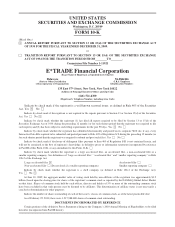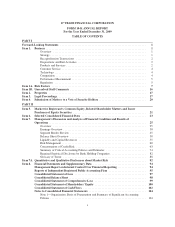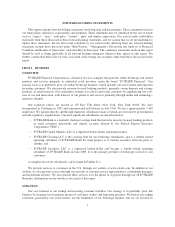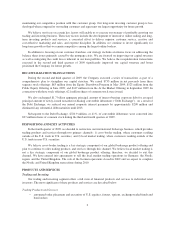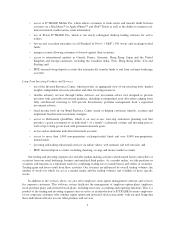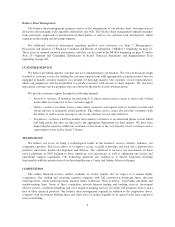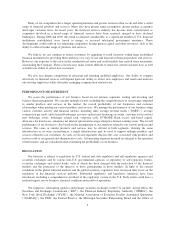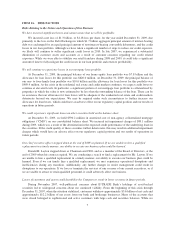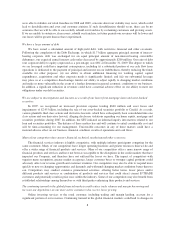eTrade 2009 Annual Report Download - page 11
Download and view the complete annual report
Please find page 11 of the 2009 eTrade annual report below. You can navigate through the pages in the report by either clicking on the pages listed below, or by using the keyword search tool below to find specific information within the annual report.were able to stabilize our retail franchise in 2008 and 2009, concerns about our viability may recur, which could
lead to destabilization and asset and customer attrition. If such destabilization should occur, there can be no
assurance that we will be able to successfully rebuild our franchise by reclaiming customers and growing assets.
If we are unable to sustain or, if necessary, rebuild our franchise, in future periods our revenues will be lower and
our losses will be greater than we have experienced.
We have a large amount of debt.
We have issued a substantial amount of high-yield debt, with restrictive financial and other covenants.
Following the completion of the Debt Exchange, in which $1.7 billion aggregate principal amount of interest-
bearing corporate debt was exchanged for an equal principal amount of non-interest-bearing convertible
debentures, our expected annual interest cash outlay decreased by approximately $200 million. Our ratio of debt
(our corporate debt) to equity (expressed as a percentage) was 66% at December 31, 2009. The degree to which
we are leveraged could have important consequences, including (i) a substantial portion of our cash flow from
operations is dedicated to the payment of principal and interest on our indebtedness, thereby reducing the funds
available for other purposes; (ii) our ability to obtain additional financing for working capital, capital
expenditures, acquisitions and other corporate needs is significantly limited; and (iii) our substantial leverage
may place us at a competitive disadvantage, hinder our ability to adjust rapidly to changing market conditions
and make us more vulnerable in the event of a further downturn in general economic conditions or our business.
In addition, a significant reduction in revenues could have a material adverse effect on our ability to meet our
obligations under our debt securities.
We are subject to investigations and lawsuits as a result of our losses from mortgage loans and asset-backed
securities.
In 2007, we recognized an increased provision expense totaling $640 million and asset losses and
impairments of $2.45 billion, including the sale of our asset-backed securities portfolio to Citadel. As a result,
various plaintiffs filed class actions and derivative lawsuits, which have subsequently been consolidated into one
class action and one derivative lawsuit, alleging disclosure violations regarding our home equity, mortgage and
securities portfolios during 2007. In addition, the SEC initiated an informal inquiry into matters related to our
loan and securities portfolios. The defense of these matters has and will continue to entail considerable cost and
will be time-consuming for our management. Unfavorable outcomes in any of these matters could have a
material adverse effect on our business, financial condition, results of operations and cash flows.
Many of our competitors have greater financial, technical, marketing and other resources.
The financial services industry is highly competitive, with multiple industry participants competing for the
same customers. Many of our competitors have longer operating histories and greater resources than we do and
offer a wider range of financial products and services. Other of our competitors offer a more narrow range of
financial products and services and have not been as susceptible to the disruptions in the credit markets that have
impacted our Company, and therefore have not suffered the losses we have. The impact of competitors with
superior name recognition, greater market acceptance, larger customer bases or stronger capital positions could
adversely affect our revenue growth and customer retention. Our competitors may also be able to respond more
quickly to new or changing opportunities and demands and withstand changing market conditions better than we
can. Competitors may conduct extensive promotional activities, offering better terms, lower prices and/or
different products and services or combination of products and services that could attract current E*TRADE
customers and potentially result in price wars within the industry. Some of our competitors may also benefit from
established relationships among themselves or with third parties enhancing their products and services.
The continuing turmoil in the global financial markets could reduce trade volumes and margin borrowing and
increase our dependence on our more active customers who receive lower pricing.
Online investing services to the retail customer, including trading and margin lending, account for a
significant portion of our revenues. Continuing turmoil in the global financial markets could lead to changes in
8

